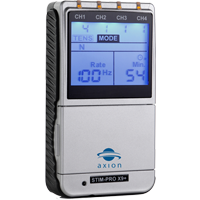TENS application for arthritis

Arthritis is a disease of the joints caused by inflammation. In monoarthritis, only one joint is affected, in polyarthritis, multiple joints are affected. The inflammation usually occurs in flares and can then manifest itself in stabbing joint pain, redness, swelling, morning stiffness, exhaustion or joint effusion.
The symptoms often restrict everyday life, as do sporting activities. In conventional therapy, the pain of those affected is treated with strong drugs that have both analgesic and anti-inflammatory effects, such as diclofenac, ibuprofen, indomethacin or piroxicam, so-called non-steroidal anti-inflammatory drugs (NSAIDs). These and other anti-inflammatory drugs often have severe side effects.
Pain treatment using transcutaneous electrical nerve stimulation (TENS) can be a side-effect-free alternative to NSAIDs[1][2]. A TENS device transmits electrical impulses to the skin via electrodes, which has two effects. For one thing, the electrical impulses can block the transmission of pain to the brain, which may mean that the pain caused by arthritis can no longer be felt. On the other hand, the TENS application can support the natural pain control mechanism of our body so that its own painkilling substances, the so-called endorphins[3], are released. TENS can also promote blood circulation[4].

-

This guide is for orientation purposes and does not replace the supervision of a doctor or therapist. Please follow the warnings and safety instructions of your device. Changes and errors are possible.
-

Number inside the circle: Channel number
Circle color: Red = Electrode 1, Black = Electrode 2
The recommended programs for axion TENS devices
*The STIM-PRO Eco is a manual TENS device. If you have not received parameter settings from your therapist, please use a frequency range between 70 and 120 Hz (burst mode 2 Hz) and a pulse width range between 150 µs and 200 µs.
Please note when using TENS:
The intensity should be adjusted so that it is felt as a pleasant tingling sensation. The duration of the application should be approx. 40 minutes in order to be able to achieve a lasting reduction in pain. It also makes sense to switch programs every now and then.
Causes of Arthritis
The advantages of pain treatment with TENS
-

From everywhere
You can use TENS therapy anywhere. It doesn't matter whether you're sitting comfortably on the sofa or in the office.
-

Drug free
TENS pain therapy is an alternative to drug pain treatment
-

At any time
You can use TENS flexibly and at any time. Success can already be achieved after the first treatment
-

Free of side effects
When used correctly, pain treatment with TENS has practically no side effects
Studies and scientific sources








